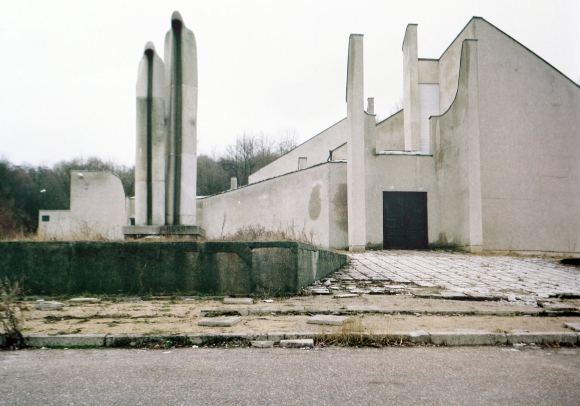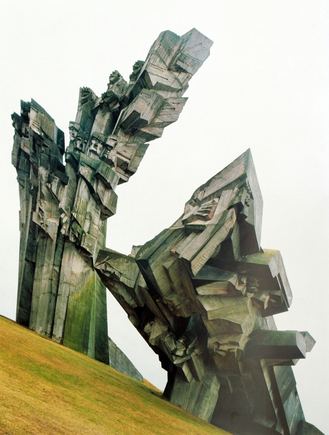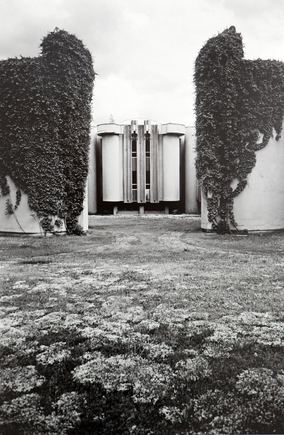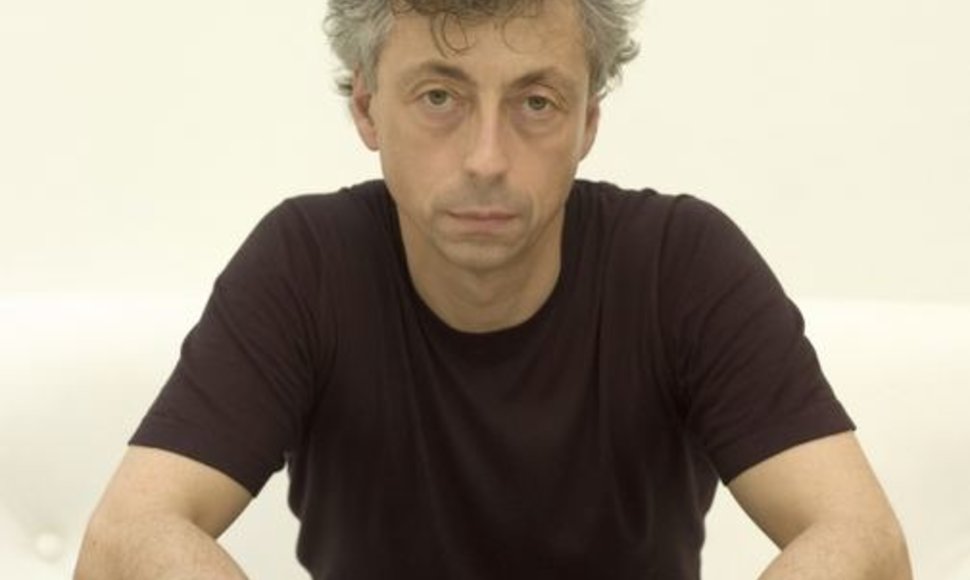It turned out that in one of the more remote buildings of the poultry house – a Soviet-era prophylactorium – still contained valuable pieces of applied art. Frederic Chaubin wanted to photograph works by two well-known Lithuanian artists, ceramicist Audronė Skarbaliūtė and sculptor Leonas Glinskis.
The poultry farm workers let us in quite willingly but couldn't help grinning at our purpose of visit – what is there to see? However, Frederic's face lit with joy when, walking through shabby rooms that still betrayed their former ambition of design, he came across an icicle-like lamp hanging from a ceiling in the narrowest of rooms. He took out his camera immediately.
His latest interest is in remaining artefacts of Soviet modernism. Frederic's passion for unusual objects took him to post-Soviet areas that he has been touring far and wide for the last fifteen years.
Last year, Taschen published his album “Cosmic Communist Constructions Photographed” with the most interesting examples of Soviet modernist architecture of the 1970s and 1980s. “The beauty of Soviet brutalism” is the caption chosen by the publisher for the album. A small part of the pictures are currently exhibited in Vilnius “Vartai” gallery, in the show “Soviet Architecture Photo Albums” running until 17 March.
Chaubin, who is also the editor of French fashion magazine Citizen K, is an expert on Soviet architecture, yet he also scouts for smaller treasures, usually neglected or forgotten by local people.
 |
| Asmeninio Frederico Chaubino archyvo nuotr./"The Beauty of Soviet Brutalism“ |
Derelict prophylactoriums, gloomy basements, cubby-holes of disintegrating buildings – such places still house some of the best works by our artists of thirty or forty years ago. “Pools in former kolkhozy were decorated like Hollywood mansions,” laughs Frederic, incredibly.
- What tempted you to come to the former USSR?
- My first trip to Lithuania fifteen years ago was very short, just four days long, but I was very impressed and wanted to come back. At the time, we were making special issue of a magazine about traveling in the defunct Soviet Union. I approached the Georgian Embassy for an interview with the then president Eduard Shevardnadze. It didn't come through then and they let me do it only four years later! I didn't understand why. The interview took place right before Shevardnadze got deposed during the Rose Revolution. Of course, I wasn't aware of that – I was editor of a fashion magazine. Naïve as I was, I went to Georgia, interviewed Shevardnadze and was put to shame when it got published – as the President was no longer in power.
But it was this trip to Georgia that made me first see the buildings that gave impulse to the entire project. I bought a Soviet-edition book on Georgian architecture in a street of Tbilisi. In it, there were photographs of very unusual buildings.
Over the following few days I photographed them myself, without knowing exactly what I was to do with the pictures. About six months later, when I visited Lithuania that I was already quite familiar with from my trips to the fashion week, I met a woman who worked on the Druksininkai Waters project (currently, Water Park). She was an engineer and architect's widow (Aušra Šilinskienė, architect Romualdas Šilinskas).
She told me what it was like, how much freedom her husband had in creating forms for the building. She said her husband was mostly inspired by works of Antoni Gaudi. That explains the highly unusual look of the building. I went to Druskininkai, took pictures of the building and realized that it was related to those I photographed in Georgia. It belonged to the same period and was almost equally crazy. I though there must be more similar building in the former Soviet states.
Finally, in 2011, an album was published. It was a sort of finale to traveling, when I decided I had enough pictures for a decent book.
- You said you found that architecture crazy. What was so crazy about it?
- It simply surprised me a great deal. Very hard to explain – I am not a scholar and I do not specialize in architecture. It relates more to my personal experience. These building, however, were unlike anything I'd seen before in other parts of the world, they did not correspond to my imagination of Soviet architecture. This architecture is much more original.
 |
| Asmeninio Frederico Chaubino archyvo nuotr./"The Beauty of Soviet Brutalism“ |
In a way, I was very lucky to come across the building in Tbilisi and Druskininkai first, as they are indeed among the most interesting pieces in the book. They are linked by the expressionist spirit that distinguishes them from the rest of modernist architecture of the Soviet period. They belong to the last two decades of the Soviet Union and express architectural blooming of a system in collapse.
These buildings had public functions – they were sanatoria, theaters, museums. There was a giant gap between these buildings and the remaining mass-produced architecture in the Soviet Union.
- What is the value of these distinctive pieces of architecture now?
- I see them as certain outsiders, curiosities, but their value is very difficult to define. I recall how I once took part in a symposium in Geneva and dined with a very well-known French architect. He got drunk and hard-pressed me to admit that I was simply in love with those buildings and that was why I thought them beautiful. Ever since, I've been sort of obliged to admit that those buildings are indeed beautiful. Therefore, yes, I do think they are beautiful.
At the same time, they are monsters, as they defy all standards. So even if they are not beautiful – which is very hard to tell objectively – they are certainly very exciting, as they were born somewhere in the middle between mutation and revival – something that gives them power. It's not that important to decide whether they are beautiful or ugly. They are simply exceptional and that makes them very exciting.
I've always been attracted to things that don't follow rules. Besides, as I've said, they belong to a period of the system's collapse that swooped up along with it the aesthetic these buildings belonged to. And yet they remain standing there and they're not even that old – thirty or forty years. Now they're surrounded by architecture of entirely different sort – one strongly affected by Western influences that came with the liberal system.
In general, I was interested in how the West and the East influenced each other during the Cold War. I think that one of the reasons behind the Soviet downfall was that it did not in fact confront the West but rather dragged behind their achievements. For instance, I find the story of the Tu-144 plane, which was a copy of the “Concorde,” symbolic. In 1973, this identical-looking plane was taken to Le Bourget air show in Paris. But the plane, that was supposed to make such great impression on the West, simply crashed.
- You are not only interested in Soviet architecture but also in smaller works of applied art. Don't you think that the latter were much more depreciated than architecture and were greatly damaged by their new surroundings, even to the point of being doomed to extinction.
- Curiously, these applied art pieces have much in common with what was being created in the Western world at the same time. So they're equally crazy, since they belong to a very specific era – the 70s and 80s. In a sense, they give in to Western influences and express Soviet psychedelics, the East imitating the West. They followed the path of Western aesthetics, but somehow adapted their works to local realities, so they're not the same what we've got in the West, but rather Eastern version with local identity. Therefore Uzbek items are nothing like Lithuanian, as both nations have strong traditions that distance them one from the other.
There is little interest in these works now, because political, social, and historical circumstances require more time to pass. Perhaps the return of interest is about to have begun. It takes some time to acknowledge this world, as the collapse of the USSR was followed by an enormous political shock. There are still residues of the sense of guilt from the period, but it should pass soon. And then it will be realized that what we're dealing with are veritable pieces of art, irrespective of what period they come from. If such realization does not come, there will be a great void, as if nothing had happened in those years.
 |
| Asmeninio Frederico Chaubino archyvo nuotr./"The Beauty of Soviet Brutalism“ |
But that would be ridiculous, since you had painters, sculptors, architects, ceramicists. Lithuania has a strong stained-glass tradition. All these people were neither more nor less talented than those who created their works before or after.
By the way, their works were helped by one more of the Soviet paradoxes: most of the artists had more time to create as they felt no pressure related to profit. In a sense, they could make secret space for themselves to make these works. They were in the position of refugees, so they could afford to ignore the system, forget everything and make, yes, masterpieces. Just imagine a piece of wood on a wall, carved in totally abstract manner. It takes one to two years! Some artists in Lithuania actually did it and in doing it, they were fleeing the reality around them.
When you ask about the fate of these works, I must remind that many places are undergoing renovation that must have done harm to original works. For example, Druskininkai Waters don't look the way they used to. The renovation cannot be satisfactory as it tries to reconcile the irreconcilable.
I mean that when one encounters an original building, one must leave it the way it is. There are at least several more buildings of superb architecture, completely neglected and falling apart. This happens to buildings of every historical period, but the worst thing is that afterwards one might have to reconstruct buildings as fakes, pretending they are just the way they were. The Soviets thus reconstructed Trakai Castle and now there is the Royal Palace next to the Cathedral, built in exactly same spirit. Rather than building imaginary palace, perhaps it would be more advisable to give some money to preserve what still remains?
What's depressing is that because of this rejection of soviet art en masse, many applied art works were not preserved. You have the “Neringa” restaurant and that is pretty much it. Many great pieces simply disappeared, I don't know where they are. Some are kept in private collections.
- I've heard you saying that, in general, Lithuanian artists stand out in the context of former Soviet countries. Why?
- I don't mean furniture as furniture in Lithuania was ugly enough, even in such privileged places like “Auska” villa. However – perhaps I'm wrong – works of applied art were extremely pretty and interesting, so I think that Lithuania must have had a very good school of crafts. Because art works were of extremely high technical quality. The same is true of photography, you have got some remarkable images from the Soviet period.
For instance, Lithuanian stained-glass artists were commissioned to work throughout the Soviet Union, they would go to Caucasus, to Tashkent and further. Irena Lipienė did a stained-glass piece for Tashkent TV Tower, while Konstantinas Šatūnas created stained-glass for sanatoria across the Soviet Union. They were commissioned in other Soviet republics because they had specific Lithuanian skills that were acknowledged elsewhere.
- On your recent visit to Lithuania, you've met several artists, most of them having worked in the Soviet times. What are your impressions from these meetings?
- They are now retired and are happy to receive a foreigner interested in their past work. Maybe they should get more recognition than they do. It's understandable for political reasons. However, French artists, who did exactly the same in the same period, get considerably more attention, they're often prosperous, while as far as I've seen, artists in Lithuania are not well off. They simply worked for the state and that's it.
For example, if you enter the first floor of the “Neringa” hotel, you'll see a marvelous abstraction in wood, by Laimutis Ločeris (“Vilnius of Ages”). Ločeris currently lives in student residence hall, completely forgotten. It's appalling, bearing in mind that his work is being exhibited in the lobby of a luxurious hotel in city's central avenue. Meanwhile, he is waiting for death, left completely alone, having to fight with noisy neighbours.
People I've met are very simple, leading simple lives, and one might think they're completely gray. But that's not true. They are talented artists.












